Television broadcasting and production company AMC Networks (NASDAQ:AMCX) fell short of analysts' expectations in Q1 CY2024, with revenue down 16.9% year on year to $596.5 million. It made a non-GAAP profit of $1.16 per share, down from its profit of $2.36 per share in the same quarter last year.
AMC Networks (AMCX) Q1 CY2024 Highlights:
- Revenue: $596.5 million vs analyst estimates of $601.1 million (small miss)
- Operating income (GAAP): $110.2 million vs analyst estimates of $130.2 million (15.4% miss)
- EPS (non-GAAP): $1.16 vs analyst expectations of $1.65 (29.8% miss)
- Gross Margin (GAAP): 54.5%, in line with the same quarter last year
- Free Cash Flow of $144.1 million, up 119% from the previous quarter (large beat)
- Company "recently strengthened our balance sheet by completing a series of financing transactions that meaningfully extended our debt maturities"
- Market Capitalization: $604.7 million
Originally the joint-venture of four cable television companies, AMC Networks (NASDAQ:AMCX) is a broadcaster producing a diverse range of television shows and movies.
AMC Networks was founded to create orginal, high-quality television and film content. The company's first channel was AMC, known for its classic movies, and it has since expanded to include BBC America, IFC, SundanceTV, and WE TV. These channels offer a variety of genres to audiences.
The company's portfolio features critically acclaimed original series, independent films, and documentaries, and it generates revenue through cable licensing fees, advertising sales, and digital streaming.
In response to the evolving media landscape, the company has effectively balanced traditional cable broadcasting with online streaming. This dual-channel strategy expands its reach as it appeals to both traditional cable subscribers and an increasingly online audience.
Broadcasting
Broadcasting companies have been facing secular headwinds in the form of consumers abandoning traditional television and radio in favor of streaming services. As a result, many broadcasting companies have evolved by forming distribution agreements with major streaming platforms so they can get in on part of the action, but will these subscription revenues be as high quality and high margin as their legacy revenues? Only time will tell which of these broadcasters will survive the sea changes of technological advancement and fragmenting consumer attention.
Competitors in the television and media production industry include Lions Gate Entertainment (NYSE:LGF.A), Paramount Global (NASDAQ:PARA), and Warner Bros. Discovery (NASDAQ:WBD).Sales Growth
A company's long-term performance can indicate its business quality. Any business can enjoy short-lived success, but best-in-class ones sustain growth over many years. AMC Networks's revenue declined over the last five years, dropping 3% annually. 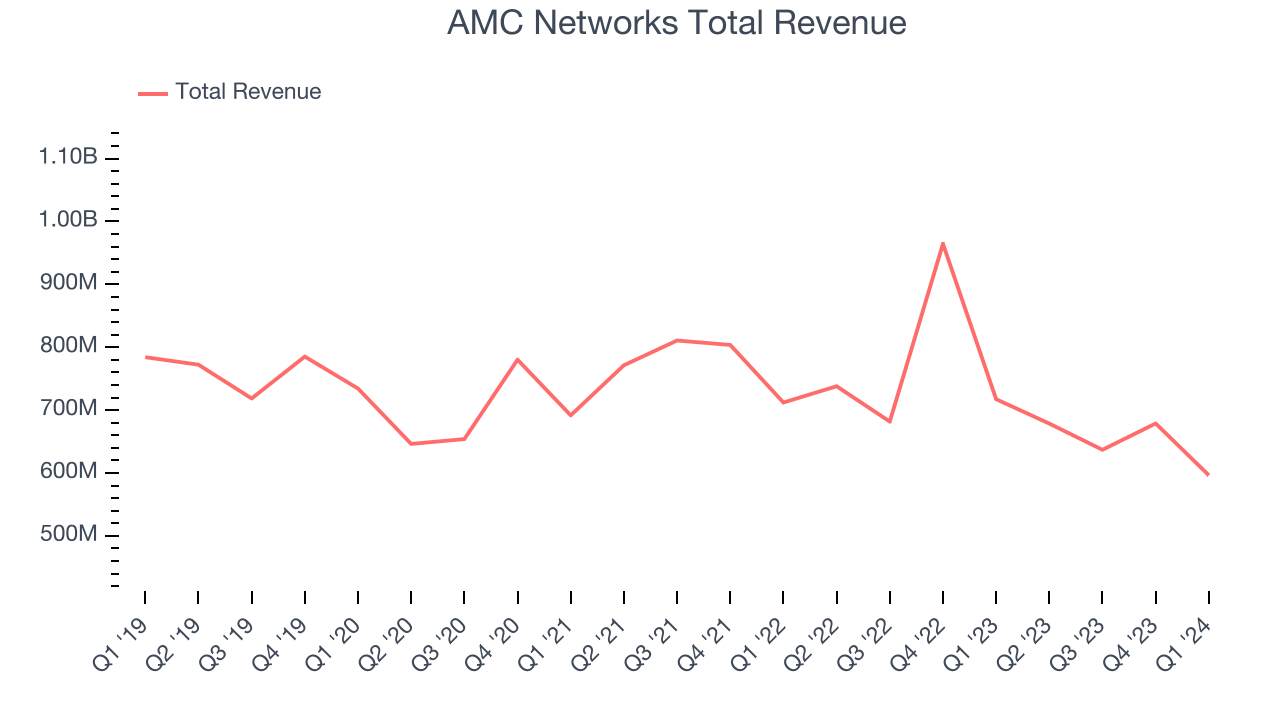 Within consumer discretionary, a long-term historical view may miss a company riding a successful new product or emerging trend. That's why we also follow short-term performance. AMC Networks's recent history shows its demand has decreased even further as its revenue has shown annualized declines of 8.6% over the last two years.
Within consumer discretionary, a long-term historical view may miss a company riding a successful new product or emerging trend. That's why we also follow short-term performance. AMC Networks's recent history shows its demand has decreased even further as its revenue has shown annualized declines of 8.6% over the last two years.
This quarter, AMC Networks missed Wall Street's estimates and reported a rather uninspiring 16.9% year-on-year revenue decline, generating $596.5 million of revenue.
Operating Margin
Operating margin is a key measure of profitability. Think of it as net income–the bottom line–excluding the impact of taxes and interest on debt, which are less connected to business fundamentals.
AMC Networks was profitable over the last eight quarters but held back by its large expense base. It's demonstrated subpar profitability for a consumer discretionary business, producing an average operating margin of 5.3%.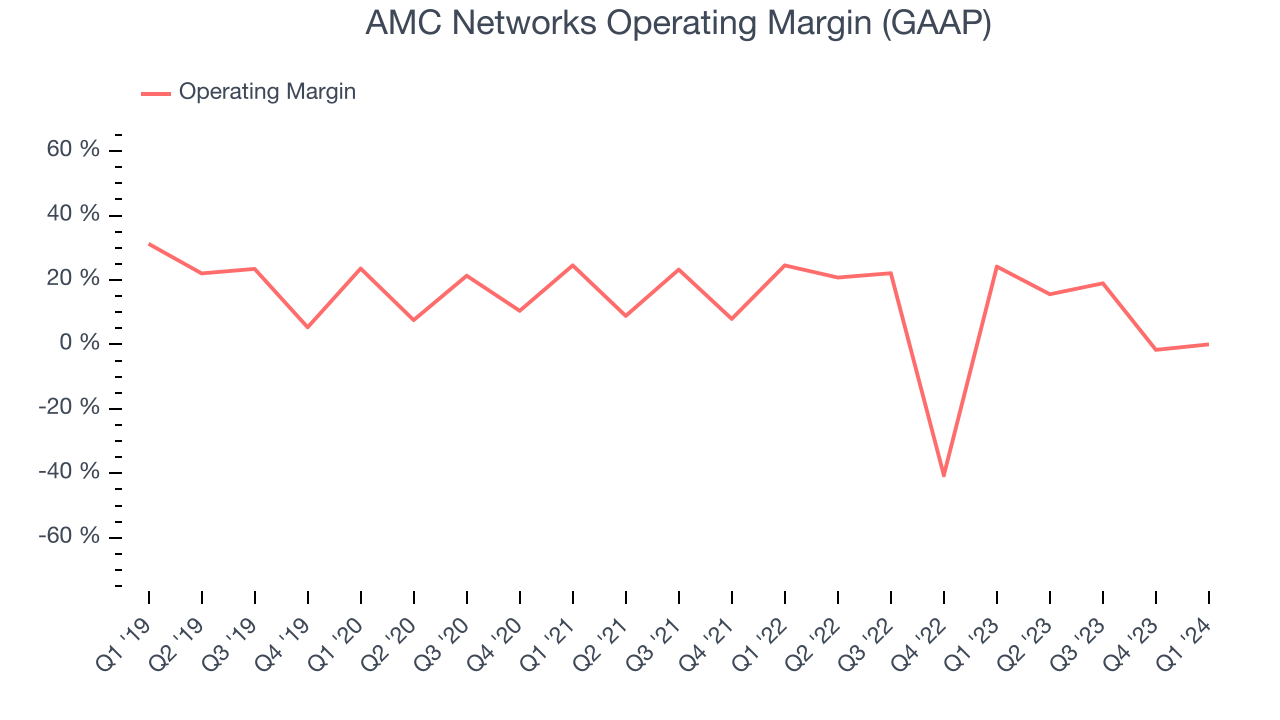
This quarter, AMC Networks generated an operating profit margin of 0%, down 24.1 percentage points year on year.
EPS
We track long-term historical earnings per share (EPS) growth for the same reason as long-term revenue growth. Compared to revenue, however, EPS highlights whether a company's growth was profitable. 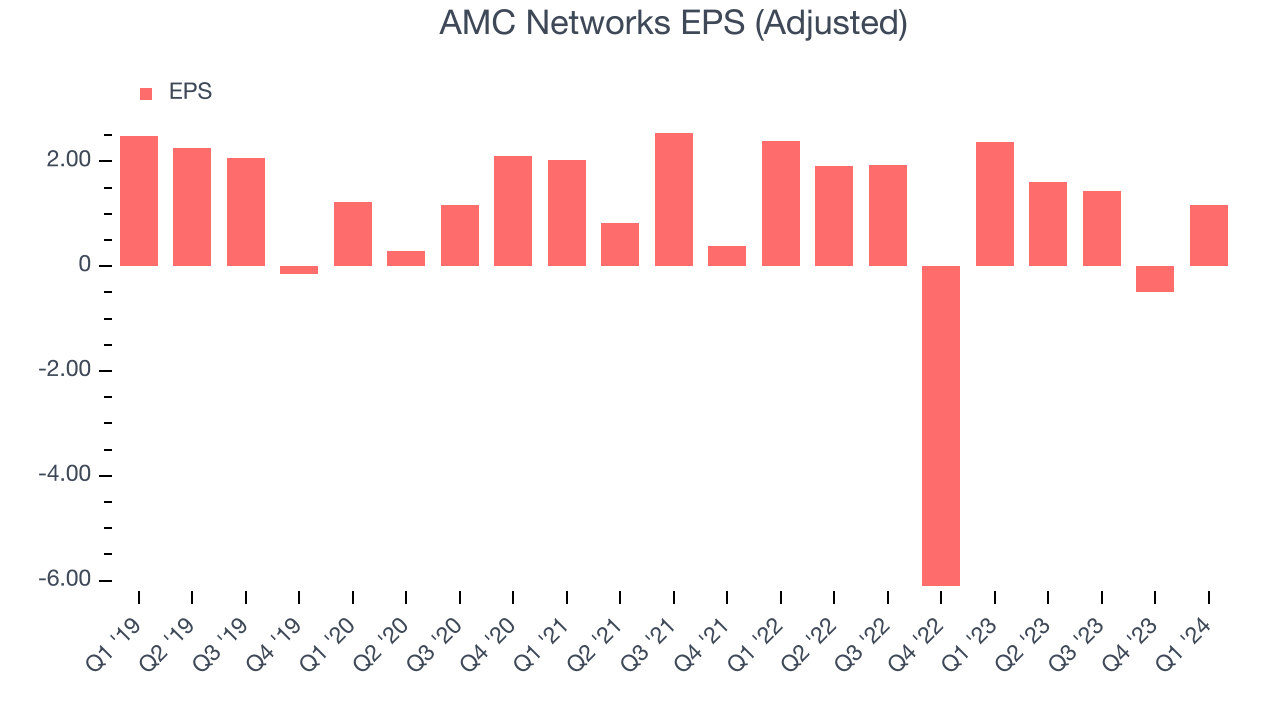
Over the last five years, AMC Networks's EPS dropped 85%, translating into 13.1% annualized declines. We tend to steer our readers away from companies with falling EPS, where diminishing earnings could imply changing secular trends or consumer preferences. Consumer discretionary companies are particularly exposed to this, leaving a low margin of safety around the company (making the stock susceptible to large downward swings).
In Q1, AMC Networks reported EPS at $1.16, down from $2.36 in the same quarter last year. This print unfortunately missed analysts' estimates. We also like to analyze expected EPS growth based on Wall Street analysts' consensus projections, but unfortunately, there is insufficient data.
Cash Is King
If you've followed StockStory for a while, you know we emphasize free cash flow. Why, you ask? We believe that in the end, cash is king, and you can't use accounting profits to pay the bills.
Over the last two years, AMC Networks has shown mediocre cash profitability, putting it in a pinch as it gives the company limited opportunities to reinvest, pay down debt, or return capital to shareholders. Its free cash flow margin has averaged 8.5%, subpar for a consumer discretionary business.
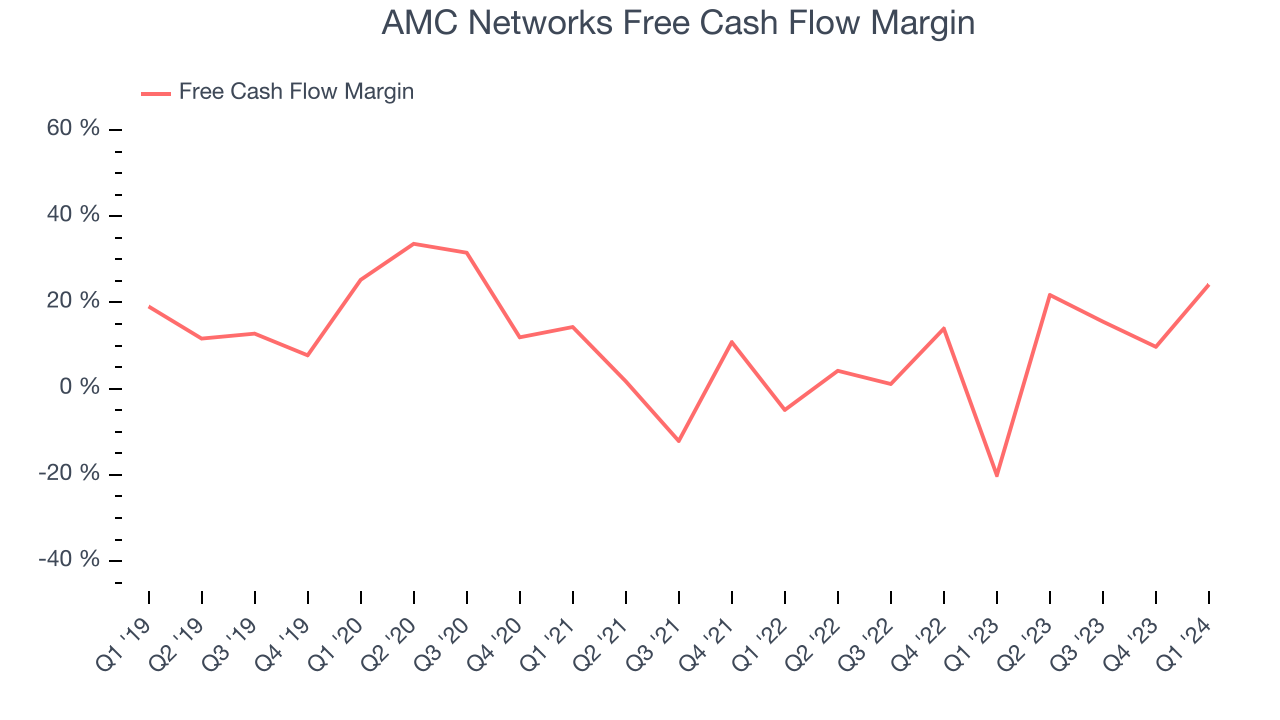
AMC Networks's free cash flow came in at $144.1 million in Q1, equivalent to a 24.2% margin. This result was great for the business as it flipped from cash flow negative in the same quarter last year to cash flow positive this quarter.
Return on Invested Capital (ROIC)
EPS and free cash flow tell us whether a company was profitable while growing revenue. But was it capital-efficient? A company’s ROIC explains this by showing how much operating profit a company makes compared to how much money the business raised (debt and equity).
AMC Networks's five-year average return on invested capital was 10.8%, somewhat low compared to the best consumer discretionary companies that pump out 25%+. Its returns suggest it historically did a subpar job investing in profitable business initiatives.
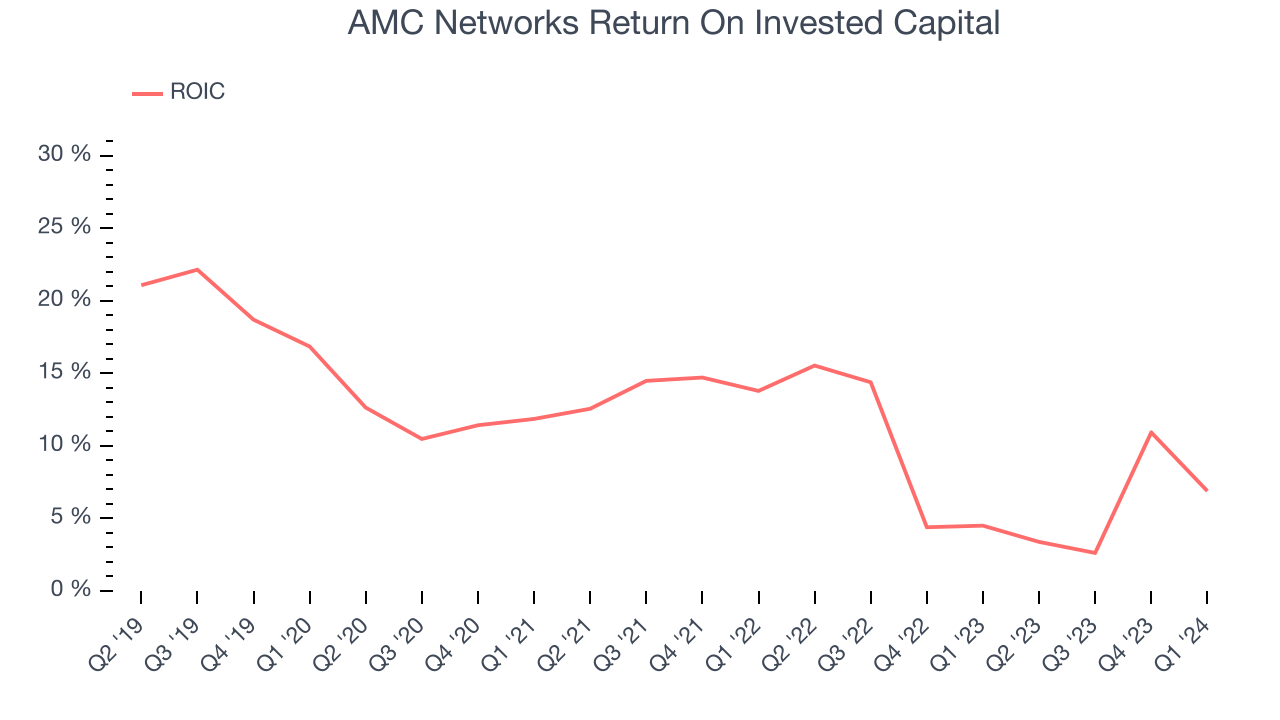
The trend in its ROIC, however, is often what surprises the market and drives the stock price. Unfortunately, AMC Networks's ROIC averaged 8.7 percentage point decreases over the last few years. Paired with its already low returns, these declines suggest the company's profitable business opportunities are few and far between.
Key Takeaways from AMC Networks's Q1 Results
The company's operating margin missed and its EPS fell short of Wall Street's estimates. On the other hand, free cash flow beat handily. AMC Networks also strengthened their balance sheet by completing a series of financing transactions to extend debt maturities. Overall, this was a mixed quarter for AMC Networks. The stock is up 1.9% after reporting and currently trades at $14 per share.
Is Now The Time?
AMC Networks may have had a tough quarter, but investors should also consider its valuation and business qualities when assessing the investment opportunity.
We cheer for all companies serving consumers, but in the case of AMC Networks, we'll be cheering from the sidelines. First off, its revenue has declined over the last five years. And while its projected EPS for the next year implies the company's fundamentals will improve, the downside is its declining EPS over the last five years makes it hard to trust. On top of that, its operating margins are below average compared to other consumer discretionary companies.
While there are some things to like about AMC Networks and its valuation is reasonable, we think there are better opportunities elsewhere in the market right now.
Wall Street analysts covering the company had a one-year price target of $12.83 per share right before these results (compared to the current share price of $14).
To get the best start with StockStory, check out our most recent stock picks, and then sign up for our earnings alerts by adding companies to your watchlist here. We typically have the quarterly earnings results analyzed within seconds of the data being released, and especially for companies reporting pre-market, this often gives investors the chance to react to the results before the market has fully absorbed the information.
